








Bugger - in my haste to get amongst the wild things, and the places they frequent, I’d left home without my leather hunting belt. Attached to it are a knife in its sheath and a small canvas pouch with a PLB, spare ammo and, most importantly, my ‘piggin string.’
For me with my dicky knee it’s often easier to pull an animal downhill than to carry it. My piggin’ string - with a handle at one end, loop on the other and a swivel in the middle - ensures the retrieval process is relatively easy.
Bugger again – yesterday I hosted a gaggle of women and drove them places –beforehand I’d stripped my ute clean of Kim-clutter. Now the important things box sits forgotten at home. In it is my spare knife and sheath, and my spare 'piggin string', loo paper and many other ‘essentials.’
Loath to forgo my afternoon hunt I scrounge
through my ute and discover my ‘emergency knife.’ A racy red, and razor sharp, wee dagger hidden deep within my glovebox. Perfect. I shove it in my trouser pocket, sling my Tikka .223 over my shoulder and walk into the wilderness.
O cially it’s summer, but up here in the high country the memo has yet to be received. It is cool, drizzling, and misty. Of a breeze there is little, a lick this way or that occasionally, an aimless waft a ected by contours and temperature.
The vegetation and spider webs are adorned like liquid tiaras. The new blackberry growth is lush and bright lime green. The soft leaves, highly palatable and nutritious, attractjng every cloven hooved animal going.
I intend to ditch the Just a Pig Hunter label today. I am a competent stalker too. Plan A is to utilise the conditions - neutral breeze, soft ground and an abundance of feed - to stalk the tiny clearings littering the forest between
the track and the hill. It is intense, close quarters hunting with rifle scope wound to minimum magnification and all senses on high alert. In an area where I am regularly outwitted by extremely wary fallow, I slowly stealth along rows of pines. The layer of fallen needles, softened by the rain, meaning my footfalls are completely silent. There is sign aplenty. Baubles of pig shit, oblong goat pellets, big soft red stag droppings and fallow beds. A rabbit scuttles from under my feet. I am in the zone and loving it. A dozing pig sees me





No.8 bow strings epitomise New Zealanders can-do approach to life. Designed by Advanced Archery’s Carol and Kevin Watson for our rugged conditions and made right here in New Zealand. We’ve refined the latest string building techniques, equipment, and materials we use through constant field testing to get the string quality we’re excited about.
Go Kiwi with all black or choose from thousands of colour combinations with clear serving to customise it your way.
Pre-stretched for zero peep rotation, with speed buttons installed and a bow tune, we’ll send your bow back to you shooting as good as new, maybe even better!

before I see her. I was close enough to smell her musky odour, and knew she was just here somewhere but she had the advantage of lying still while I was on the move. She jumped to her feet, growling as alarmed pigs do, then trotted o with many a backwards glance. An older model sow with hips and ribs protruding, she is safe from my bullet.
On through the many clearings, vegetation dripping wet and tendrils of steam rising slowly.
The various turds so fresh they’re shiny and the various prints on the muddy trails still well-defined despite the rain. If this isn’t a stalker’s heaven, I don’t know what is - in harmony with Nature and being part of the predator-prey equation.
Then, across Table Eleven, our eyes meet. We acknowledge each other’s existence without a blink. He is so caught out, he has a leaf protruding from his lips. He has not yet heard me, cannot smell me, his eyes are yet to bulge in alarm and in that moment, before he registers the danger I represent, I quickly lift the rifle and find his shoulder in the scope. At the shot he bounds o ,
fleeing as if untouched. I stand stock still and listen as he dashes from clearing to cover. Heavy cover. Up, up and away.
Did I miss? At that short range - are you kidding me?!
So many trails through the soft wet grass. So many prints on the trails. So much blackberry and gorse. It is a maze.
Eventually, relieved, I find a splatter of lung blood. I did not miss.
I track like Sherlock. Up and up, sometimes on hands and knees, sometimes tangled or hog-tied by unforgiving blackberry vines. Dead gorse is in my hair, down my neck, down my cleavage and in my bra. Not many predators wear a bra!
Beneath a mat of barbed vines, I lay eyes on him a second time. He does not blink this time either. The half-chewed leaf has gone, as has all his life blood.
He looks handsome in his summer coat and colourcoordinated velvet – a sleek, smooth and beautiful little creature. I feel a deep sense of regret. I wish now I had missed, or he had outwitted me as usual. Getting out of here is no fun. I leave the buck’s
insides in to ensure he’s not contaminated with debris then drag, curse and reverse butt-first downhill till we emerge back at the clearings. The buck has remained sleek, and smooth, but I now resemble a woolly mammoth, with sticks and pricks all over and grey hair a’ tangle. Time now to blood the wee dagger, and to consider the drag across the flat to the forest track. This going butt-first in reverse caper is not on, and my knee is beyond carrying any excess baggage. The answer is at my feet. Or, more specifically, on my feet. Criss-crossed and looped around my boot is a long and strong lace - a pink lace - because this predator not only wears a bra - she also wears pink. I return from my afternoon ‘wilderness experience’ in a right old mess. My pulling arm now feels a metre longer than its o sider. The gorse prickles have gravitated from the back of my neck to my knickers and the chasm within. I am saturated and dishevelled - hurting but happy – and satisfied in a way only a fellow bush stalker will understand.
Kingfish are a special fish to target o the kayak. They pull extremely hard and aren’t straightforward to catch, so every fish I land is cause for celebration. When you throw in the mix targeting a big one, it becomes even more complex.
Mechanical jigging and live baiting are my primary ways to catch kingies o my kayak, and recently, I’ve managed to tick o my first half a dozen for the summer; none of the fish were particularly large, but it was good to get a warm-up for what’s to come over the rest of the summer.
It seems to be a running theme in my fishing to catch a species when targeting something else, and on this day, it was no exception.
I headed out to a favourite area but found sign in much closer, no use paddling over it. I dropped down a black magic Sunakku and quickly
hooked up to the target species for the day, a nice gurnard. By paddling along and watching for marks, I am able to bomb a Kabura right down into the general area that the fish has just been.
I know for a fact that if a jig is falling, the fish will show interest. They might not eat it, but there’s every chance this will be enough to cause the fish to bite.
The next drop was onto a similar mark spotted just o the bottom. I felt the sand, gave a few winds, and my rod loaded up. Uh oh, that’s not a gurnard. Line screamed o my reel at an alarming pace, with the fish taking over 100 metres in short order.
I turned the rudder and gave chase; the fish powered away strongly and managed to tow my kayak at 2.5 kilometres an hour purely from the load on the rod. This continued for around 20 minutes, the fish managing to keep the pace up the whole time.
I took my time on the light gear, slowly making a dent in the fish’s energy bit by
bit. Eventually, the weight began to rise through the water column, and the fight slowed. Obviously, pulling the kayak for half an hour was starting to take its toll. Colour appeared below the kayak, and a long green
and yellow fish circled up to the surface in a big, wide arc. It was a kingfish, and a really nice one at that. The nice part about fishing with light gear over sand is that once the fish gets to the boat, it’s mostly tired out,
and landing becomes quite easy.
In this case, the kingi swung around, and I grabbed its tail on my first attempt, stopping it dead in its tracks. It protested, and I hung on as its final few
kicks rippled through my shoulder. It was over; the Kingfish was beaten on this occasion. I slid it up onto my lap and managed to barely fit it in the rear well. I wish all second drops of the day were this good!




The indexed rotating clamping system has 3 angle adjustments 12˚, 20˚, 25˚ always keeping your knife in the same place







This story begins with Sir Alister Hardy (1896-1985) who invented the Continuous Plankton Recorder (CPR).
Sir Alister was the son of an architect, and following war service went to Oxford in 1919, studying zoology, graduating with distinction. He was taken on as zoologist on the RRS Discovery voyage to the Antarctic between 19251927 and it was during this voyage he invented the Continuous Plankton Recorder (CPR). His groundbreaking research into plankton and his design of the CPR is still the basis for much of the global plankton work carried out today.
Alister was knighted in 1957 to recognise his groundbreaking work in marine biology.
A CPR survey was implemented in 1931 in the North Sea and North Atlantic and is still carried out today. This is one of the longest-running marine biological monitoring programs in the world and has identified and continues to monitor major changes in marine ecosystems. How does the CPR work? The unit is towed horizontally about 10 m down from the surface and around 100 m behind the boat. As it is pulled along, water enters a small aperture at the front of the CPR body and then passes

Full credit to Sir Alister, the CPR used by us in this project today is still largely based on his original model, with some minor modifications to allow for the more extreme sea conditions in the Southern Ocean. No batteries, no apps, no digital technologyonly brass gears, steel wires, a bit of preservative and a timeless clever design. Sir
through a 270 µm filtering collecting silk (See figure 2). An external propeller advances the silk at a rate of around a cm for each nautical mile towedindependent of the speed of the ship. This ‘filtering silk’ then a ‘covering’ silk, and any plankton caught are trapped between the two layers. These sandwiched silks are then rolled storage
where a supply of bu ered formaldehyde preserves the sample. At the end of each tow lasting around 420 nautical miles the silks are recovered, labelled and stored in formaldehyde At this point new silks can be inserted, and another tow commenced. On return to port, the silks are removed from the mechanism and divided into sections representing 10 nautical miles (19 km) of tow.
In 2008 an agreement was made between government (now MPI), Sanford Limited, and NIWA to use Sanford science representatives on the longline vessel San Aotea II to carry out CPR transects on north and south transits between New Zealand and the Ross Sea toothfish fishing grounds.
The initial aim of this project was to map quantitative changes in the distribution of epipelagic plankton, including phytoplankton, zooplankton and euphausiid (krill) life stages, both within New Zealand’s EEZ and the Ross Sea, Antarctica. Extending from just south of the port of Timaru to the Ross Sea, the exact route has varied over seasons due to the fishing locations chosen and the seasonal distribution and concentration of sea ice in the south. Since 2008 about 30 north and south transits have been carried out by San Aotea II.
Information provided from the 16 years of this collaborative research has provided excellent data to support various analyses such as mapping the concentrations of chlorophyll-a in the Southern Ocean, general information on the broad
In the last few days of 2023 pistol shooters in New Zealand had a win. A lot of the thanks for this has to go to the President of Pistol New Zealand (Debbie) and the hours upon hours she has spent working with the top levels of the Police in charge of firearms, and my thanks to them as well for seeing the logic in the change.
What was the change?
A requirement to have a pistol endorsement in New Zealand, above those needed for a standard
licence, is that we must shoot at least 12 times every year. Of late it had been changed so that only shoots that were held at our home club would count. For myself and a lot of others that wasn’t a problem, but for some it was. We have a number who are members of more than one club and others that have clubs with time restraints on when and how often they are open. Add to that shift work, or illness and things can get tight. Previously a number of people used to travel to away matches like our Nationals or Island Champs
Jack Fenaughty
spatial and temporal patterns of zooplankton abundances associated with environmental changes due to climate change, and quantification of micro plastics in the marine environment.
NIWA trains Sanford vessel scientific representatives to load the internal cassettes with new silks, replace these
in the body of the CPR at about 410 nm intervals, deploy and retrieve the CPR, label and preserve the samples silks, and carry out all associated recording of location and time. NIWA carries out the post-trip analyses on the collected material. General support for CPR equipment and training is also provided by Graham
Hosie and John Kitchener (Australian Antarctic Division, Hobart, Australia) and The Marine Biological Association CPR Survey).
This is now one of the longer-running time series CPR projects from the southern hemisphere/ Antarctica and continues to provide consistent, and increasingly useful trend information.
This project is a great example of industry support and cooperation (Sanford Limited) with government and research providers closing information gaps and provide an alternative and useful addition to more limited research vessel activities. This is increasingly important in times of potential changes in the environment.

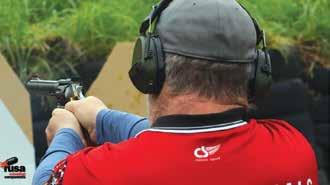
in order to ensure that they shot their 12, however this was changed so that those shoots no longer counted. From my point of view this was wrong for a few
reasons. The main being when you are away at another club you are not among your club members, so the expectations on you are tighter and you need to
prove to them that your gun handling is up to scratch. Go to our IPSC Nationals 18 stages with di erent o cials on every stage and they don’t play favourites, the other disciplines are the same, which is good for everyone as it keeps safety standards high. This is good for the licence holder and their home club as you take new skills back which helps those that don’t travel. On a very basic level 12 is 12 and that is what should count.
So as mentioned thanks to some amazing work done by our President
alongside the Police in charge of firearms, this has changed so that these away shoots now count - as long as we get them signed o at the match and our home club adds it in our yearly returns. This is both fair and reasonable as we are still doing the 12 shoots that are required. Note; we have to do 12 minimum shoots per year to keep our pistol endorsement , while Police O cers do 2 training days and don’t require a firearms licence.
It's been a challenging few months , weed everywhere we go and then damage to the drone . The adventures have been few and far between .
The first chance we had to get the Shark drone out was November 12. We were all done in 15 minutes as it was weed city, about 50 kilos of weed and not a fish in sight We packed up and went home but the next three times we ventured out it was the same thing again. We put the drone away and bent the aerial! Now the drone is at the repair shop getting sorted, which is taking forever. Just waiting now for the test flight so we can make some sort of plans for fishing.
We had a couple of good days on the rig, a few encounters with massive schools of kahawai but then the hot weather hit. Sorry but I don’t do hot.
I have been gearing up with my lure and flasher rigs and traces. Honing the skills and settling on designs and di erent line strengths. I make a range of standard drone and kontiki style traces, also surfcasting clip-on sections, 1, 2, 3,
hook rigs, options on fully tubed tangle free rigs, glow in the tubing is available.
Line weights on 390lb and can do higher on special request.
Trace hook options can be from single hook, doublefixed or floating hook system with a keeper hook option.
Trace lengths to order but four-to-six-inch droppers help give you reasonable distance to your cast.
Videos of these set ups
Wayne Gillardare on our Facebook page, Dronefish.co.nz.
Gurnard have been a regular catch around Canterbury for a few months and there are mega thousands of kahawai around. Kingfish are out under the floating kelp and bait fish galore. There is the odd snapper ,and salmon are few and far between. Good numbers of rig ,elephant fish have been hit and miss.










Senator Boats are o cially launching at Marine and Outdoors in Blenheim.
Senator Boats are synonymous with safety, comfort , and being great riding sea boats. This makes them an excellent option for inner Marlborough Sounds adventures and heading out to Cook Strait and beyond. A natural choice to have available on the doorstep to the top of the South. Marine and Outdoors have completed a handful of customer boats since becoming Senator representatives towards the end of 2023. One of these was the Senator RH650 “Garne Fishin’” (pictured). The brief for Garne Fishin was simple –the Woods family wanted to be able to take the family to and from the bach in the outer Pelorus safely and in comfort, and also have a fishing weapon to chase snapper and kingfish around D’Urville Island and beyond.


Nestled amidst the Kaikoura hinterland, the hut was a welcome sight on that clear August dawn. The omens were good: fine weather and plenty of deer sightings. The objective was to get my son his first deer—a fitting present for his thirteenth birthday.
As we lazed on the deck late in the morning, a small mob of fallow appeared on the top bush line. We went to scout a suitable spot to return for an evening hunt. Looking over the mob, we singled out a young stag that looked to be in very good condition, despite it having been a very wet and cold winter. We settled on a location and a time to return later that

To celebrate the arrival of Senator Boats in Marlborough, Marine and Outdoors are hosting a launch event on Friday 1st March.
View the full range of Senators on display covering models from IS380 to RH770. You’ll have the opportunity to see “Garne Fishin’” up close alongside
Join the team for a complimentary lunch, the chance to win some prizes and to chat with current Senator owners.
When: Friday 1st March 2024. 9am to 4pm
Where: Marine and Outdoors, 14 Horton Street, Blenheim

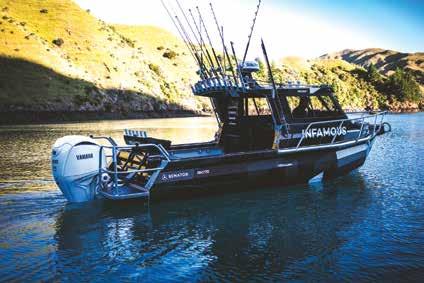
afternoon.
As the sun dipped behind the Kaikoura Ranges, the shadows lengthened and we crept into position. The question that hung in the air was, “Would the fallow return?”
The answer came forty-five minutes later as the chocolate coloured animals filtered into view; time and location couldn’t have been better. The young stag was first out, followed by a few spikers and hinds.
Nestling in behind the rifle, Soul got his breathing under control and waited for the stag to present a good shot. Then he squeezed the trigger and waited for the projectile to do the rest. It was a tidy shot and his birthday present was in the bag—a plump fallow buck and the first deer of the weekend.
We continued hunting and I got another stag and spiker— both also in good condition.
Thanks to the people who let us hunt their properties





8 - 10 2024
Registrations are open, and tickets are limited, so sign up now! www.dawnbreakers .co.nz
Fishing dates: 5pm Friday, March 8 – 5pm Sunday, March 10 2024 (backup dates 5pm Friday, March 15 – 5pm Sunday, March 17 2024).
Prize-giving dinner: March 23, Trafalgar Centre
For more information, please keep an eye on the Dawnbreakers Fishing Club Facebook page.

The Snapper Cup Fishing competition is a firm favourite on the fishing calendar each year. Held in March, this comp has just grown bigger and better each year, and Dawnbreakers Fishing Club know they are onto a winning formula.
The club has kept those aspects of the Snapper Cup, which we know and love. Thanks to our fantastic sponsors, we will have an amazing prize pool up for grabs. Major sponsors Hunting and Fishing Nelson/ Richmond and Furuno ENL have come on board again in a big way. The prizegiving event will be held again at the excellent venue Trafalgar Centre, thanks to our venue’s sponsor, DNA Boats. The club will also be fundraising again for Coastguard Nelson, a vital and valuable service provided by amazing volunteers to all those on the water in our region.
The prize pool is shaping up to be as good as, if not better than, previous years. As usual, there will be both kayak and boat divisions. There are still senior and junior categories,
so the whole family can get involved. Plus, loads of spot prizes and other items are up for grabs even if you don’t catch a winning fish.
Now, on to the exciting changes – they are definitely geared to enhance the competition!
The Snapper Cup has always been linked with Dawnbreakers membership; however, this year, membership is not a prerequisite – Snapper Cup 2024 is open to all! Dawnbreakers members will get discounted entry.
The competition has been extended, so there is now a longer window available for fishing. This will have multiple positives, allowing greater options depending on wind, weather, and tide, not to mention work and family commitments. Fishing will be allowed from 5pm Friday, March 8, to 5pm Sunday, March 10.
Plus, the area for fishing has been extended to incorporate the Golden Bay area as well, meaning the competition is open to all across the Tasman region. Those from Nelson can also head over that way to fish their favourite fishing spot.
Given these changes , the club has decided to move the competition from a weight-based comp to
a measure-based result to align with good fishing practices and environmental considerations. This will be done using the Daiwa Tournament App to simplify entries. An approved measure mat will be required for entry. You simply send the image in via the app, and results are collated behind the scenes, leaving contestants to carry on with the fun of fishing. Even better, this means no racing back to the ramp to weigh in your fish at the end of the day!
The species included in the comp are snapper, kingfish, kahawai, gurnard, and the newly added trevally. There will be prizes for the longest of the species, average length and several new trifecta categories, which will make for an exciting prize-giving. Then, to top it all o , the prize-giving and dinner will be held at the Trafalgar Centre on Saturday, March 23 – always a very enjoyable evening with talks from various sponsors and, of course, the great prizes up for grabs. This year, the catering will most certainly be delicious thanks to the team at Under The Hood providing a full bu et dinner of their slow-cooked meats and sides.


• The first is suitable for 22 Hornet through to 243 including, 222, 223, 22-250, 243.
• The second suppressor is suitable for 6.5 through to 30-06 including 6.5 prc, 270, 7mm-08, 284, 280, 308, 7.62 x 39 etc (not including 300 PRC or belted magnums).
• 9” in length (230mm), sits 4” forward & 5” back over the barrel (this is a “fixed” length and cannot be changed or added to)
• Weight 360 – 370grams (alu internal muzzlebrake 5-6,000 rnds)
• Colour - Black The 41mm 9” suppressor is most suited for those who like to clean their suppressor.
We have two multi calibre suppressors available in the hybrid model and this is possible because the hybrid ba e system has tight tolerances allowing the small ranges of calibre. The hybrid ba e system also lowers the risk of stray bullets and bullet strike www.GUNWORKS.co.nz
Like most New Zealanders I survived the sometimes challenging social engagements of Christmas and New Year and ate and drank more than I should have – an indulgence for which I am now su ering increased criticism of my expanded physical profile. Various comments from family and friends - ‘looks like you have been grazing in the good paddock’ being the mildest; ‘oi you fat bastard’ being pretty much the average –have prompted me to get a wee bit physical over the past few weeks.
In the spirit of good intentions for 2024 I went for a long walk along the coast and called in to see an old bloke who was once best mates with the ex-wife’s grandfather. Yes, I know it sounds a bit complicated, and the relationships were/ are and probably always will be. The ex-wife remarried years ago, her grandfather passed away before our marriage did, but truth be told I always got on better with her extended family than I did with her.
The grandfather was definitely one of life’s true characters. He was raised as a whangai child and maintained close ties with the marae on which he lived until he was fifteen. In his youth he had been tall and strong and a top sportsman. Regional rep for rugby, more than a handy cricket player and a very good swimmer. But his passion was fishing. He and a few good mates regularly made the long trek out to the coast and spent the day catching hapuku and kingfish o the rocks
We are talking a bit of history here – back in the day stu – the wayback machine experiences. The road to the coast was unsealed and prone to slips and even floods in bad weather. The only vehicle available was a Model A truck. Just enough room in the cab for three strapping young men; low enough geared in reverse to be able to back up the steepest of hills with a bit of a load on



the back. The fishing gear was rudimentary in comparison to what we take for granted today. No carbon fibre rods, or star drag reels; no braid or fluoro monofilament lines, and no fancy circle hooks, poppers, or jigs. Rock fishing was done with handlines
and whippy manuka sticks spooled with the cat-gut material used to lace tennis rackets. The catgut was superior to braided cotton line in that it had some ‘give’ in it and could take the shock of a big kingie claiming a floating bait. On a good day the
three fishermen would limit themselves to two kingies each person plus two hapuku, all of a good size too. Fishing success was celebrated by a tot of whiskey. Several more tots were considered to be medicinal protection against the wind and cold sea, and a tot or two extra were consumed just for general good luck. There were days when fishing was not so good – the long pauses between hook ups were filled with the chit chat of good mates and extra tots of whiskey. Never to excess of course – well almost
never.
So back to my chat with the mate of my ex-wife’s grandfather who tells me of the day that the three young fishermen found that fishing was slow despite the usual reliability of the Maori calendar – ‘a bit too much swell until the tide came in’ – and the whiskey bottle came out earlier than usual. Late in the afternoon the bite started and two very large hapuku were hauled in over the rocks. Then a few kingfish – one of them almost dragged one of the fishermen into the sea. Likely because he was o -balance due to excess whiskey consumption. It was time to head home, and the fish were consigned to wet cha sacks and loaded into the Model A. The fishing protocols included a tikanga prohibition on cleaning and gutting fish by the sea so on the way back into town a river ford was a handy spot to head, gut and fillet the catch. All the meat in one wet sack and the guts, heads, and frames in the other. And of course, a few more whiskeys to celebrate a job well done before the Model A fired up for the final stretch home.
One final fishing protocol was to dump the heads and frames over the bank at the top of the last hill as the road left the cost. Steep cli s, plenty of scavenging seagulls and no-one around to witness the o oad. The now well lubricated ex-wife’s grandfather had the disposal job and leapt out of the truck, grabbed the sack of heads, frames and guts and hurled it o the cli .
Except it wasn’t. It was not the correct sack. When the trio finally made it home an hour or so later they discovered that it was in fact the sack of fillets and steaks that was sent flying. The whiskey had impaired their judgement but totally impaired that of the ex-wife’s grandfather. So, it was hapuku cheeks and roasted frames for dinner, a massive telling o by mothers and grandmothers, and the catalyst for hapuku to be thenceforth known as the ‘whiskey fish’.

From time to time, we get enquiries from good keen sorts who want to take up pāua diving for a living. Our response is always encouraging and will generally include sharing an industry contact or two we think might be looking for a diver.
We always caution them if they want to do more than simply show up with a wetsuit and a good attitude and contract dive for an existing outfit, the legal requirements and costs are not minor.
When I started diving in the late 70’s anyone could walk into the Ministry of Agriculture and Fisheries o ce, as it was then, get a permit and go diving. You were allowed to catch and sell a tonne of pāua a week, pāua taken had to be above 125mm and that was pretty much it.
Now it is a very di erent situation.
To become a professional pāua diver in 2024, if you want to be more than just part of a dive crew, there are two routes.
1. Buy pāua quota, pāua quota shares
2. Or find someone to lease you pāua Annual Catch Entitlement (ACE). Either way you need a minimum of one tonne of ACE before you will be issued a fishing permit by Fisheries New Zealand.
Having got your fishing permit and start by acquiring the minimum ACE holding in the Quota Management Area you want to work, then the ‘fun’ begins.
You most likely will need a boat to get out to the better fishing grounds and you won’t get away with a cheap one. It needs to be a very reliable, strong and seaworthy beast to go commercial fishing.
Any commercial fishing vessel must be certified to comply with Safe Ship Management (SSM) requirements. Such as Safe Operating Plans (SOPs) or Maritime Operating Safety System (MOSS). These vessels are checked and certified regularly and at great cost.
For example, under six metre boat would cost approximately $1500 to $2000 annually and a larger boat (requiring MOSS) would cost approximately $5000
Jeremy Cooper
to $7000 annually.
• Safety gear requirements are also strictly policed and vary depending on the length of the vessel. Gear such EPIRBS, life rafts and high spec safety and survival gear call, all be requirements.
• All commercial vessels also need to be registered annually with Fishserve and marked clearly with a name and rego number. It must carry a Geospatial Position Reporting (GPR) unit. This is so MPI Fisheries Enforcement can always monitor your vessel location. The GPR unit also requires a monthly subscription to the satellite communications network at the owners expense.
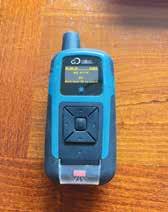
• Finally, since most pāua is exported, your boat must come up to hygiene standards certified to comply with the standards of the countries the pāua are being exported to. Generally, EU standards.
Next on the list? A skipper’s ticket.
Commercial fishing vessels are required to have a suitably qualified person
in charge. The Skipper Restricted Limits (SRL) certificate is the minimum ticket to become a skipper of a New Zealand commercial vessel. To gain an SRL takes 850 hours, which include: an 18 week/450 hour online preentry course, 200 hours of sea time, a five-week classroom course (200 hours). The SRL includes endorsements in VHF radio use, first aid, radar use and motor know-how. Having got all that set up, and now o diving, there are strict catch reporting requirements to meet. Electronic reporting (ER). Regulations require commercial fishing to be recorded and reported each day a fishing event takes place. For paua, ERs record
• the name of each diver, the Lat/long, time and date of where they entered and exited the water,
• the time spent in the water,
• how many kilos they caught and of what species,
• the Statistical Areas they fished in, the sea conditions (swell and visibility), the type of breathing apparatus each diver used (snorkel, UBA Steel or Aluminium tanks on the Chathams). These reports must be transmitted digitally to MPI by the end of each day.
Once you have finished

diving for the day, your legal responsibilities haven’t finished.
All commercially caught pāua must be landed to a Licensed Fish Receiver (LFR) who o cially weighs the catch and reports it to MPI. You are also required to submit a Monthly Harvest Return (MHR), which is used to help verify your catch.
So, it’s not straightforward. If you want to get into the industry, do your homework, and get advice from a good skipper or diver.
Some of the older divers reckon a lot of fun has gone out of the game, there are just so many requirements loaded on to what should be a pretty simple way to make a crust.
Those doing the job now continue to love the lifestyle. A day at the o ce for a professional pāua diver can be special after all.
Jeremy is CEO of the Pāua Industry Council
Quota/ Quota shares are the basis of the Quota Management System (QMS). There are 100 million shares in each fishing stock within the QMS. For pāua there are 10 Quota Management Areas (QMAs) commercially fished in New Zealand. These QMAs have varying amounts of pāua that can be commercially harvested each year. Any New Zealand citizen or entity can buy and own quota shares in any fish stock. Pāua quota shares can be purchased on a willing seller / willing buyer basis either privately or through Quota brokers operating in New Zealand. ACE-Annual Catch Entitlement. On October 1 each year, quota shares are used to generate Annual Catch Entitlement (ACE). ACE e ectively mirrors Quota shares but converts the shares to kilos of fish that can be caught each year. Many pāua quota share owners (QSOs) choose to sell their ACE rather than catch it themselves. To go commercially diving for pāua you needn’t own pāua quota, but you do need a minimum parcel of pāua ACE. ACE can either be purchased, leased or transferred to you, which allows you to harvest the ACE on behalf of the ACE owner. Such transactions are a private commercial arrangement between you and the QSO/ACE owner.

It’s amazing the number of Kiwi hunters who dream of hunting Africa. The most common expression I hear is, “It’s on my bucket list!”
It’s also amazing the number of Kiwi hunters who never get passed the dreaming stage, which is genuinely a tragedy because it’s an opportunity lost. An African hunting safari is definitely a bucket list moment but also an experience that surpasses even the most wildly optimistic hunter’s expectations. The experience creates a longing to return and leaves hunters with indelible memories.
Of all the many hunters I have introduced to African Safaris over the past decade, none have returned disappointed and many have returned to Africa on safari: some several times. There’s an old African saying: “Everything in Africa bites—but the safari bug bites worst of all!
Understandably, some are nervous about such a venture and you do hear horror stories: lost trophies,
shoddy operators, the wrong trophies back, poor quality animals, shitty taxidermy and the like. That’s why I formed Daryl Crimp’s Footsteps on Africa—to assist Kiwi hunters have an authentic safari experience minus the stress and worry of delving into the unknown.
abroad, professional hunters, documentation, taxidermy, shipping and import to NZ. I have learned that short-cuts cost money so I use well established, fully accredited operators— with the emphasis on quality.
placed in a risky situation in nearly a decade of hunting Africa!
While I specialise in South African safaris, I can organise safaris in Botswana and Zambia. Because South Africa is so vast, there
holdings, and there is a developing trend towards ‘put and take’ hunting— game bred animals oloaded for you to shoot— which is NOT my style of hunting. I like to work with established Professional

To that end, I have established a network of very professional operators in New Zealand and Africa, who assist in every aspect of the hunt: flight bookings, permits, accommodation

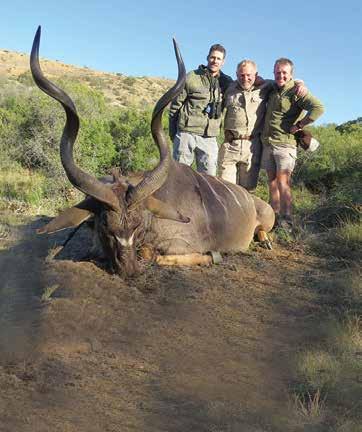
Safety is a key issue with most and rightly so. However, despite the stu you see on the news or via social media, South African safaris are very safe and don’t operate in areas of trouble or unrest—I have never felt unsafe or been
are many biomes to hunt: the bush veld, mountain savanna, East Cape mountains, low veld, Karoo and so on.
There are also many types of operators, from huge concessions to small
Hunters and Outfitters who have generally been in the game for generations and who specialise in established herds on their properties—genuine fair chase walk up hunting; no shooting from the vehicle.
Accommodation is either in
bespoke lodges or authentic safari tent camps, which a ord a great experience. And there is no shortage of animals to hunt—something like 40 plains game alone! I have hunters already booked for this year and 2025, so now is a good time If you have a dream to hunt Africa—don’t just dream it… do it. Call me now and let’s put a plan in place— together.







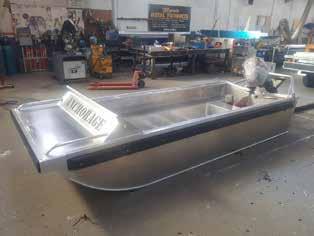




Over 30 years experience working with all types of metals, specialising in aluminium. What we do
• New boat builds
• Custom designs
• Repairs
• Modifications
• Trailers
• Marine projects
Our reputation speaks for itself, and our work consistently exceeds our customers’ expectations. Visit our website to see more.
morrismetals.co.nz
When you choose us, you’re choosing the best in the business Get in touch with us today
103 Nelson Street, Petone, Lower Hutt 5012 P 04 5689181 - enquiries@morrismetals.co.nz

New Zealand Diving and Salvage Ltd (NZDS) own and operate two Morris Metals 6m flat bottom punts.
The vessels are in commercial survey under NZDS’ Maritime Transport Operator Certificate/Plan (MTOP/C).
The 6m Punts are strong, versatile vessels that perform exceptionally well in a range of conditions.
NZDS’ clients require access to areas deemed inaccessible by other means.
The Morris Metals built vessels provide a diverse solution by design.
The shallow draft and low freeboard allow the vessels to access di cult locations such as beneath bridges, wharves and marine structures; and shallow rivers/lakes/water bodies.
The vessels are an essential piece of equipment for NZDS’ operation which includes use as a dive support vessel and open plan, stable work platform.



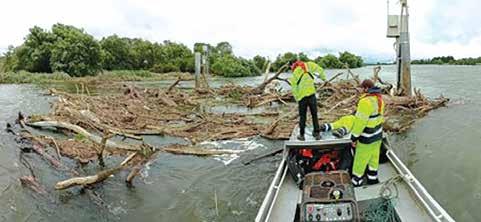
Morris Metals Ltd have been building aluminium punts for use by the marine industry since the 1990's. Over the next few issues we will profile their usage in unique marine situations.



kid fishing Ladies trips - Game fishing for Sharks CALL AND BOOK A TRIP TODAY Mobile: +64 21 843 908 Email: info@topcatchcharters.co.nz

















The Southland Times recently reported that, according to Maritime New Zealand’s Recreational Boat Survey, New Zealand has the highest boatto-person ratio in the world.
The survey results show the Tasman region having 44% of people reported owning or using a boat, the highest self-reported level in the country, followed by Marlborough at 40%.
We know the majority of those who go boating regularly put a line or pot in the water and collectively take a significant share of available fisheries resources.
It follows the importance Kiwis place on fishing for a feed warrants recognition and attention by those who manage fisheries.
Fish Mainland Inc finds ways to help the Government recognise the importance of recreational fishing. This is done by taking a proactive, forward looking, and cooperative
approach towards representing South Island fishers’ interests and working collaboratively with the other fishing sectors to better ensure fisheries and the environment are maintained for future generations.
Fish Mainland recognises the collection of better data on recreational catch and e ort is a critical step in improving fisheries management decision making, and recreational fishers are the best source of that data.
The benefit for fishers is better data informs decision making by substantiating the importance of a fishery for recreational use and fishers’ preferred fishing grounds.
Several South Island recreational fishers, fishing clubs and other groups, including the Guardians of Fiordland and Kaikoura, have highlighted the value they place on collecting more information and with greater frequency to gain a better understanding of localised trends in abundance, size distribution and availability of fish stocks important to
recreational fishers.
With funding from the Ministry for Primary Industries’ (MPI) Sustainable Food & Fibre Futures programme, Fish Mainland has collaborated with Datacom in developing a recreational fisher selfreporting system.
The data is collected via a mobile app, appropriately named Mainland Catch. It is an intuitive and simple app for fishers to use on their fishing trips.
Mainland Catch is designed like the longstanding voluntary arrangements for catch-per-unit-e ort data collected by the commercial rock lobster fishers. Over time, these voluntary arrangements have continued to improve so the data provided have become integral to stock assessments.
We anticipate Mainland Catch will provide valuable data for management and compliance purposes and at a considerably lower cost compared to other recreational data collection methods.
Currently, Mainland Catch is being redeveloped using tools that simplify its roll out to both iOS and Android platforms. This redevelopment will provide an improved user interface for creating trips, adding fishers, and recording catches while also providing both light and dark modes to improve usability in bright sunlight conditions while at sea.
The new version of Mainland Catch, to be released in March 2024, will also improve performance and responsiveness, and enable the secure capture and retention of catch and e ort data to allow detailed reporting to MPI on several fisheries important to recreational fishers. It will also support reporting in both English and Te Reo languages.
Whether you fish from a kayak, a 6+ metre powerboat or the beach, we encourage all fishers to do their part in sustaining fisheries by fishing within set limits and using


Mainland Catch to record their catch and e ort data
Our website www. fishmainland.nz steps you through becoming a Fish Mainland member, which is free. If you support our work, you can also donate through the website or via direct debit to our bank account 03 0823 0101056 000.





16 Thomas Peacock Place
St Johns Auckland
P O Box 42 064
ORAKEI 1745
Telephone: (09) 5277-009
Facsimile: (09) 5277-001
Email: dschofield@magnumnz.co.nz
Website: www.magnumnz.co.nz
BUSINESS – FOR SALE MAGNUM (NZ) LIMITED
This well established business which is 100% New Zealand owned and operated has been producing neoprene Waders and Wetsuits for 20 years.
This well established business which is 100% New Zealand owned and operated has been producing neoprene Waders and Wetsuits for 20 years.
We manufacture a full range of neoprene Chest Waders, Trouser Waders and Thigh Waders which are various brands of gumboots. Dive Suits are also part of our inventory.
We manufacture a full range of neoprene Chest Waders, Trouser Waders and Thigh Waders which are available in a wide range of sizes and are fitted with various brands of gumboots. Dive Suits are also part of our inventory.
This Business has a broad range of customers including Retailers, Marine Farmers, Councils, Government Departments and Commercial Users
This Business has a broad range of customers including Retailers, Marine Farmers, Councils, Government Departments and Commercial Users
There is potential for you to grow this business due to the emphasis on maintaining environmental sustainability and the impact of Climate change.
There is potential for you to grow this business due to the emphasis on maintaining environmental sustainability and the impact of Climate change.
This is a great opportunity to own a small Business which operates Monday to Friday from modern premises in St. Johns Auckland and can be easily relocated.
This is a great opportunity to own a small Business which operates Monday to Friday from modern premises in St. Johns Auckland and can be easily relocated. If you are a practical hands on person this could be the business for you.
For further information please contact the owner –
For further information please contact the owner – Derek Schofield Ph 09 5277 – 009 Email: dschofield@magnumnz.co.nz

Mokihinui, up the road from Westport, is home to the best little fishing competition in the South Island.
The 23/24 comp had almost 200 fish weighed in by the 100-plus fishers staying in their baches, the Mokihinui Camping Ground, or over the river at the Gentle Annie camp.
It’s a magical spot with safe swimming for kids and great fishing for all. Between tides or if conditions improve, you can shoot up to Karamea(the end of the road) or stroll around the local attractions in and around Westport.
The West Coast Pie Co., with its wild meat fillings, are rated by most.
The 24/25 Mokihinui Fishing Comp kicks o on Boxing Day and runs until Jan 4…with a “Take A Kid Fishing” competition running mid-January.
The organisers reckon getting accommodation sorted well ahead of time is a must.



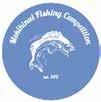

I recently wrote two Optically Speaking articles about the new Pulsar Merger LRF XQ35 thermal binocular and the Pulsar Axion 2 LRF XQ35 thermal monocular. I have since spent more time using these devices. This article is a summary of my experience and conclusions.
At first glance, the size and weight is the most noticeable di erence because the Merger LRF is a binocular (bi-ocular) weighing 0.83kg, whilst the Axion 2 LRF is a compact monocular weighing 0.47kg and able to fit into a pocket. I found that both units are easy to carry and use, but I personally find that the Merger is more comfortable to carry due to its neck strap. The Merger is also fitted with a proximity sensor that switches the unit into ‘sleep mode’ when moved away from the face and then instant start-up when using again; I really like this feature.
Despite having the same sensor and objective lens, the optical characteristics are di erent due to the Merger having a larger AMOLED display. Both devices have the same field-of-view, but the base magnification of the Merger is 3x, whilst the base magnification of the Axion is 2x. The Merger is better for spotting and identifying objects, however, I found that the Axion was better for walking at night due to its
For our first trip of the season, we headed to Kaikoura for a long weekend as it is only about two and a half hours from Christchurch.
Our road trip has its own little rituals, after hitching up our Osprey and leaving Christchurch, our first stop is for a co ee and scone at Amberley and then two hours later we are at the southern end of the Kaikoura Coastal Road. The windows wound down; we enjoyed the warmth of spring with the tang of salt in the air being driven by the wind of the nor’ wester. It was soon

lower magnification.
My first experience with the Merger LRF XQ35 was a prolonged night-time walk with the Merger around my neck and Axion in my hand for comparison. I found that I would look through the Axion when walking, before
switching to the Merger for scanning. To begin with, I found this confusing because I thought both units had the same magnification. Once I had spotted the base magnification at the bottom of each viewfinder, I understood why. If you
Michael Hendriksto turn to disappointment as we stopped at the South Bay boat ramp to large rolling swell and nasty waves on top as the wind continued to increase. Time to head to the bach we had booked by the Pier Hotel.
The following morning, we woke to calm conditions but as we arrived at the South Bay Marina there were only a few cars in the park, due to the large southerly swell from the last few days’ weather. After launching our boat, we headed out for some fishing and bait for the cray pots. We only managed to get enough bait for the cray pots and drop them in and head back to the bach to enjoy a beer or
two at the Pier Hotel. We checked the forecast for the following morning, and it was going from bad to worse as the wind direction was changing from northwest to southerly with increasing swells.
It’s the morning of our last day in Kaikoura and we are up extra early to head around again to South Bay Marina. The sunrise is stunning this morning, as we leave the marina and head out to rescue our pots braving large incoming swells, the wind is increasing At least the pots are nice and close by and within 10 minutes we commence
do a lot of night walking, the Axion would be a good choice.
The Pulsar Merger LRF XQ35 with its two eyepieces has a far superior viewing experience than a monocular. The image is larger and the experience
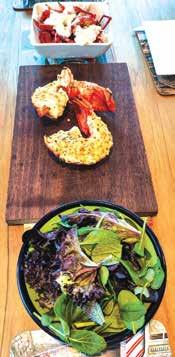
The Axion 2 LRF XQ35 is $3,599 while the Merger LRF XQ35 is $6,999. If you want the extra image clarity and comfort of a binocular thermal imager, the extra cost is well worth it.
On the other hand, the Pulsar Axion 2 LRF XQ35 is lighter, smaller, better able at providing night-time navigation and costs less. Slipping it into a jacket pocket when not in use is very handy. Everyone will have their own likes, dislikes, budget and image requirements. Both devices deliver an excellent thermal imaging option, but in their own way, each is quite di erent.
Common features:
• Manufactured in Europe by Pulsar
• 384x288 Lynred STD-810/833 TWS Qualified sensor
• NETD <25mK
• 35mm f1.0 precision germanium lenses
• Laser rangefinder
• Video recording and streaming via Wi-Fi
• Firmware update and remote control via Stream Vision 2
• Advanced image processing, control and colour palettes
• Fully waterproof Mg alloy housing
more immersive. It’s a bit like going to a cinema and watching with both eyes against watching with one eye closed! Detail is better and it feels far more natural. As well as the extra size and weight of the Merger, there is also a price di erence.
hauling them up. Nothing in the first pot, but as we lifted the second there is a lone crayfish, well at least we caught something, we lift the final pot and nothing. We make a final turn and head back to the safety of the marina and as we look back, the southerly was howling and swirling around creating white caps. We clean the boat and head back to the bach to pick up our gear and make the trip back to Christchurch with, ‘the lone crayfish". We had plenty of time to discuss what recipe we were going to use.
It’s Monday night after a long weekend fishing and
• Quick-change battery (Merger also has an internal back-up battery)
• 3 year warranty
For more information please visit www. advancedoptics.nz
friends
Time
As we enjoyed our stunning meal and reflected on our trip, perhaps it was time to appreciate quality not the quantity as some times, ‘less is more.’

From soldier to fishery o cer, adventure called, and Gareth Manson answered.
Looking for a new adventure after a lengthy career in the army, Gareth Manson found it as a Senior Fishery O cer in the Deep South.
Gareth has been a fishery o cer for around four years – a job where the o ce is often on the move both on the land and at sea.
“When the opportunity came up, it was too attractive to let it pass me by and after 19 years in the New Zealand Army, I was ready to take on a new challenge,” he says.
One of Gareth’s main jobs is skippering the 7.5-metre Osprey patrol vessel, Toro.
“I’ve been behind the wheel for the past three years. It’s a shared role, and when I’m driving, I’m responsible for the safety of up to three Fishery O cers. Our work at sea means we’ll go alongside both recreational and inshore commercial vessels for
compliance checks on their fish catch and gear,” he says.
Gareth also manages a team of Honorary Fishery O cers (HFOs). HFOs are volunteers who are trained to a similar level as Fishery O cers and do about 50 per cent of recreational compliance work.
“They’re passionate volunteers, ranging in age from their 20s to 70s. They
do a huge amount of work with us on the water or along the coasts. In addition to compliance work, they’re invaluable to our educational work, ensuring people are aware of the rules and regulations". Further information, including rules for other fish species, is available on MPI’s website or by downloading the free NZ Fishing Rules app.
“We’re always on the hunt for new HFOs. If you love the ocean and are enthusiastic about protecting the environment and the sustainability of fish resources – give it a shot, as you might have many of the skills we’re generally looking for. One of my favourite parts of our work is interacting with many di erent people I wouldn’t meet in my daily
life if I wasn’t a Fishery O cer,” he says.
Gareth has never been a chained-to-the-desk employee. When it comes to his work life, the attraction is the unpredictability of each day.
“We’re monitoring compliance of recreational fishers from the land and sea. We’re also focused on inshore and deep-water commercial vessels and restaurants or retailers dealing in seafood. The work of Fishery O cers is remarkably diverse – one day, we can be patrolling the Catlins coastline, and the next day, we could be patrolling in the waters of South Westland Jackson Bay,” he says.


Meanwhile, you might think that outside work, Gareth takes a break from the ocean; however, it’s a big part of his recreational life, too.
“I’m a keen fisher and boatie and recently got into spearfishing. I love everything about the ocean, whether swimming and surfing with my daughter or just being there. The Dunedin coastline is unique,” he says.
If you have questions about becoming an HFO, email HFO@mpi.govt.nz
MPI encourages people to report suspected illegal activity through the Ministry’s 0800 4 POACHER number (0800 476 224).








The region from the top of Takaka Hill to the tip of Farewell Spit is a combination of many complex parts. Locals and visitors are the custodians who must work together to maintain this and pass it on to future generations.
‘The Bay’ has no place for those who disrespect it.- those who let dogs loose to hassle the little blue penguins, who drive on beaches where birds nest, who poach on other people’s property, or who break the laws of the land.
A recent court case brought to the public’s
attention the ‘excessive and repeated o ending’ of a local commercial fisherman . A long string of prosecutions over 25 years, numerous breaches of the Fisheries Act, a number of convictions and massive fines, and the loss of several fishing vessels around the Golden Bay Coast make for tragic reading. Mixed in with this is the death of a crewman and the "Fisherman’s tendency to fall asleep at the wheel’, to tell lies and make up excuses (“lies”) when appearing in court.
Convictions include:
• 1996, fined $4,000 making false statement.
• 2006, $15,000 fine
fishing in marine reserve
• 3 months salvage.
• In Dec. 2023, the Fisherman again in court , fined $16,000 for failing to carry and operate a geospatial reporting device. December 2023, fishing vessel and associated floating cache forfeited to the crown.
The Fishing Paper will report on future developments. Whilst name suppression is not in e ect the Fishing Paper has chosen to not name the Fisherman.






MERGING CLASSIC DESIGN WITH ADVANCED TECHNOLOGY
The Pulsar Merger LRF thermal binocular delivers a comfortable, immersive viewing experience with enhanced detail rendition. Viewing with both eyes also reduces eye fatigue during prolonged observation periods.
Pulsar Merger LRF common features
• 1000m laser rangefinder
• Lynred STD-810/833 TWS Qualified sensor
• Supplied with an APS3 battery and charger
• Quick-change battery with internal back-up battery adds significant operation time
• Tough waterproof magnesium alloy housing
• Overidable proximity sensor
• ¼” tripod mount
Three models available to suit various budgets and operational requirements.
Merger LRF XQ35
All the great features of its high-end siblings. Compact, great image quality, fog, rain and foliage penetration. Excellent value.
Merger LRF XP50
The most popular Merger combines fine image detail with deep fog, rain and foliage penetration. The best all-round Merger for Pros and hunters.
Merger LRF XL50
The ultimate thermal offers a very wide field-of-view, amazing image detail and high magnification zooming capability.



